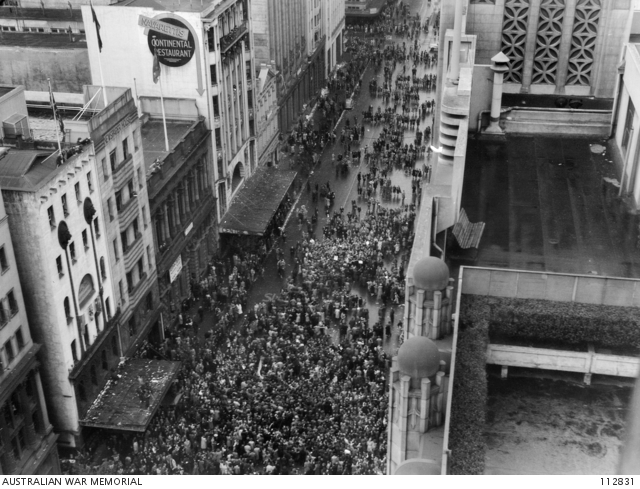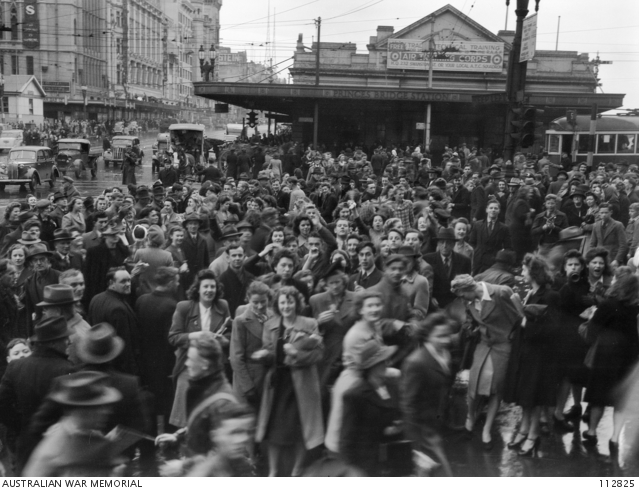75th anniversary of the end of the Second World War
15 August 2020 marks the 75th anniversary of the surrender of Japan in Australia. This is considered the end of the Second World War and is referred to here as Victory in the Pacific Day or simply ‘V-P Day’ (the UK, US and New Zealand prefer ‘Victory over Japan Day’).
The end of the bloodiest conflict in the history of the world is worth celebrating and remembering. We may never know the exact number of people killed or injured – it seems that every time we recount it keeps rising – but the present-day estimates now range between 70 and 80 million people.
So what does this date signify and why should we care today?

To start, let’s look at why V-P Day is commemorated on this particular day.
Japan entered the war against the Allies on 7 December 1941 by launching surprise attacks against Hawaii, Malaya and other locations throughout Southeast Asia. They invaded and occupied thousands of kilometres of territory throughout the Pacific and South Asia while also continuing the brutal war in China. Eventually the combined Allied forces drove Japan out of most of these areas.
By 1945, a sufficient number of airfields had been built or captured to allow the projection of huge amounts of air power over the Home Islands by the Allies. In an effort to avoid what would have been a protracted and unthinkably bloody invasion, the United States used this air power to instead drop two atomic bombs on the cities of Hiroshima and Nagasaki on the 6 and 9 August respectively. The very next day, 10 August, the Japanese Government informed the Allies of its intention to surrender, provided that the position of the Emperor was maintained.
One other significant but lesser known event also played a large role in Japan’s decision to surrender. The same day that the second atomic bomb was dropped, the Soviet Union declared war on Japan and commenced its invasion of Manchuria – something that Japan had feared for many decades.
The reason why 15 August is V-P Day and not 10 August is because Japan’s surrender was not officially or publicly accepted by Emperor Hirohito in his radio broadcast until 15 August. Technically it was announced on 14 August in Japan, but due to the timezone difference, this news was not received in the United States and Europe until the 15th.
As you can imagine, the news was greeted warmly all around the world. When the announcement by British Prime Minister Clement Atlee reached Australia over the wireless at 9am, people were understandably overjoyed.
Atlee concluded his broadcast with: “Peace has once again come to the world. Let us thank God for His mercy.”
Now let’s have a quick look at what it was like in Melbourne.
People had a few days to prepare. The Commonwealth Government declared the 15 August as ‘Victory Day’. It also made it a public holiday and encouraged people to “fly flags and decorate buildings with bunting”.
Public transport in Melbourne continued to operate to cater for the huge crowds expected. Passenger trains ran as usual, while trams and buses ran to normal timetables but were stopped at the edges of the CBD to avoid conflicts with people on the streets. They also had to contend with a shortage of drivers who had either joined up with the armed forces over the duration of the war or were liable to join in the public celebrations. Night trams (yes they had those back then) would not operate into the CBD until 1am. If you’re interested in all the gunzelly details of transport for the day, see this link.
Hundreds of thousands of people flocked onto the city’s streets as the news was announced. Returned servicemen, police and civilians all joined in the celebrations.
Crowds were everywhere, from St Paul’s Cathedral…

…to the General Post Office on the corner of Bourke Street and Elizabeth Street…

…and all the way up and down Collins Street.

People were, quite literally, singing and dancing in the streets.

In all the excitement, some apparently got a little too carried away. In an editorial on page 2 of The Age on 15 August, the newspaper condemned the “irresponsible revellers” who caused havoc across parts of the city. This included breaking windows, setting off fire alarms and even “…interference with trolley poles [for trams] on gradients”.
Celebrations weren’t confined to Melbourne of course, with celebrations across the world and the country. Victorian country towns, many of whom had lost quite a high proportion of their populations to two world wars in the space of a few decades, joined in welcoming the peace. Reports came in from right across the state, including Horsham, Sale and Wodonga.
In contrast, the good burghers of Bacchus Marsh and Melton appear to have been somewhat more restrained. The Express, a local newspaper, reported that: “There was no wild rejoicing, but instead a sober attitude and a general desire to find a quiet corner to ponder on the wondrous fact that Australia had emerged from six years of war”. The only commotion to occur was “a midnight clatter of tin cans, motor horns and the ringing of the bell at State School No. 28 [which] disturbed slumber to a certain degree”.
But the 15 August wasn’t the end. Events and parties continued into the following weeks in Melbourne, including a Victory Day parade down Swanston Street on 24 August with over 22,000 military personnel participating.
Speaking of trams, I couldn’t finish this post without including this photo of crowds outside Flinders Street Station, which includes a view of a tram and Princes Bridge Station in the background.

The Second World War had an indescribably large impact on pretty much everything that we have today. The 75th anniversary of its conclusion is an opportunity to reflect on this and also consider how lucky we are now to live in a time of relative peace.
Footnote: thanks to the Australian War Memorial for releasing many images and materials on their website in the public domain. This is where the photos for this article have come from. See their website here for more.